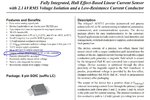Mithun_K_Das
Advanced Member level 3
- Joined
- Apr 24, 2010
- Messages
- 899
- Helped
- 24
- Reputation
- 48
- Reaction score
- 26
- Trophy points
- 1,318
- Location
- Dhaka, Bangladesh, Bangladesh
- Activity points
- 8,252
100A AC current measurement. Yes its a easy job to do with CT and Shunt resistor.
But if I use ACS sensor (hall effect current sensor) instead of Shunt resistor will it be a wise decision?
Will it be precious enough to measure up to 100A AC current?
I'm using 100A:5A CT and shunt resistor to ADC of microcontroller.
But if I use ACS sensor (hall effect current sensor) instead of Shunt resistor will it be a wise decision?
Will it be precious enough to measure up to 100A AC current?
I'm using 100A:5A CT and shunt resistor to ADC of microcontroller.


